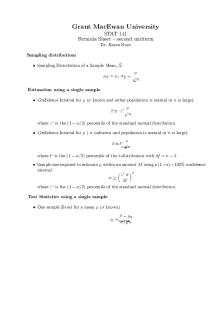Antibiotic table - Lecture notes lecture 2 PDF

| Title | Antibiotic table - Lecture notes lecture 2 |
|---|---|
| Course | Introduction to Pharmacy Practice |
| Institution | Kingston University |
| Pages | 5 |
| File Size | 294.7 KB |
| File Type | |
| Total Downloads | 6 |
| Total Views | 137 |
Summary
antibiotics...
Description
Inhibition of bacterial cell wall synthesis Bacetercidal/Bacteriostatic
Mechanism of action
Bactericidal [Broad spectrum (spectrum varies due to different bacteria possessing different transpeptidases]
Inhibits bacterial cell wall synthesis: via inhibition of transpeptidase activates autolysins (endopeptidases) which act on sites in the peptidoglycan cell wall to degrade it bacteria undergoes suicide/lysis due to fluid moving in
Resistance Some bacteria produce β-lactamases (penicillinases) therefore preparations contain inhibitors to overcome this: β-lactamase Inhibitors • Clavulanate – with amoxicillin (coamoxiclav) – with ticarcillin (Timentin) • Tazobactam – with piperacillin (Tazocin)
SE’s
Anaphylaxis/allergy (cross sensitivity) Rash (urticaria), fever, joint pains, angioedema GI problems (more common with broad spectrum): diarrhoea, nausea & vomiting, antibiotic-associated colitis (Pseudomembranous colitis)
Extra Info. Drug Interactions with Penicillins • Aminoglycosides • Oral contraceptives • Probenecid – piperacillin
Penicillin G • Susceptible to degradation by beta lactamases • Cannot be taken orally as degraded/hydrolysed by stomach acid • Narrow spectrum i.e. gram-positive cocci, gram-positive bacilli & gram-negative cocci (not effective against G-ve rods) • More active than Penicillin V (i.e. not equivalent potency)
Penicillins
-CLOXACILLINS [Antistaphylococcal penicillins]/ Penicillinase-resistant penicillins • Methicillin no longer Px’d but used in labs to determine MRSA status • Flucloxacillin – Acid stable, can be given orally or injection – Well absorbed from gut – Adverse effects • Cholestatic jaundice (Caution in hepatic impairment) • Allergic reactions • Temocillin – Active against gram- & B-lactamases – Given as a last resort after 3rd generation cephalosporins Broad-spectrum penicillins • Ampicillin – Absorption affected by presence of food – Produced by modification to structure of penicillin G (more lipid soluble than penicillin G so can penetrate outer lipid membrane of G rods in order to get to cell wall, therefore broader spectrum – Can be taken orally • •
Amoxicillin derivative of ampicillin, reaches higher plasma and tissue concentrations – Absorption not affected by presence of food SE: – Maculopapular rashes & diarrhoea
Antipseudomonal penicillins • Available in combination with clavulanic acid only – Timentin is ticarcillin plus clavulanic acid – Tazocin is piperacillin plus clavulanic acid • Expensive so only used in specialised conditions • Against non-pseudomonads similar spectrum to ampicillin but less effective • Useful for gram-negative infections especially with pseudomonas • SE: – Rashes are common – High Na+ content so high doses hypernatraemia – Inhibits platelet function
Inhibition of cell wall synthesis
Bacetercidal/Bacteriostatic
Mechanism of action
Bactericidal Broad-spectrum
Inhibits bacterial cell wall synthesis
Generation
Drug
Gram activity
1st
Cefalexin, Cefradine, Cefadroxil Cefoxitin Cefaclor
Low More gram+ selective Higher G+ selectivity G- selectivity
Cefotaxime, Ceftazidime, Ceftriaxone
Highest G-selective
Cephalosporins
2nd
3rd (orally available)
Resistance
SE’s
Resistrance: occurs due to the production of β-lactamases (cephalosporinases)
Resistance to Blactamases Low
CNS Penetration
Indication
Poor
UTI & minor RTI
Higher
Poor
Highest
Allergic reactions (hypersensitivity and 10% cross-allergy with penicillins) Antibiotic-associated colitis Renally excreted so dose adjustment needed in renal impairment Poorly penetrates CSF unless meninges are inflamed (cefotaxime for CNS infections)
Equivalent to ampicillin plus activity against betalactamase producing organisms activity against haemophilus Good Ampicillin-like activity plus Drugs of high activity against choice for penicillinase producing bacterial organisms especially meningitis in haemophilus, pseudomonas children and anaerobes Severe sepsis incl. severe pneumonia, meningitis (especially blind therapy) and surgical prophylaxis
Extra Info. –
Inhibition of cell wall synthesis Bacetercidal/Bacteriostatic Monobactams (Aztreonam)
Carbapenams
Ertapenam
Bacitracin
Vancomycin
Based on B-lactam structure Broad-spectrum (against gram+ & gram-ve, aerobic & anaerobic organisms Used to treat septicaemia in context renal, intra-abdominal, chest sepsis esp. in immunocompromised
Mechanism of action
Resistance
SE’s
Based on B-lactam structure Active against gram-negative organisms; used to treat septicaemia or complicated UTIs
Allergic rashes GI upset Liver and marrow toxicity
Imipenem is partially inactivated in kidney by enzymes therefore given with cilastatin (specific enzyme inhibitor) to prevent renal metabolism Meropenem similar to imipenam but stable to renal enzyme therefore can be given without cilastatin. Less seizue-inducing potential and can be used to treat CNS infections
B-lactam SE’s and neurotoxicity in high doses or renal failure Seizures Confusion
Broad-spectrum
Extra Info.
License: abdominal & gynaecological infections and community acquired pneumonia but not active against atypical respiratory pathogens and limited activity against penicillin-resistant pneumococci. Also licensed for foot infections and soft tissue infections in diabetics
Peptide Bactericidal Mostly effective against gram + Ototoxicity (tinnitus and deafness) Nephrotoxicity [monitor plasma conc. (like aminoglycosides >90% eliminated by glomerular filtration)] ‘Allergic' reactions (mast cell releaser so if given by rapid IV causes 'red-man' syndrome!)
Glycopeptide antibiotic, bactericidal, for gram+ve cocci Given via I.V, avoid oral route for systemic infections due to low absorption
Inhibition of protein synthesis
Indicated for serious specific conditions Clostridial pseudomebranous colitis Staph. aureus inc penicillinase producing and MRSA Streptococcal endocarditis if penicillin-sensitive Peritonitis in CAPD patients Teicoplanin similar to vancomycin but longer duration of actions. Given via I.M & I.V but not mouth
Spectrum
Mechanism of action
Resistance
Binds to ribosome and blocks protein synthesis (Bacteriostatic) Effective against gram +ve Similar range of action & efficacy to penicillin
Decreased permeability of drug into microbe Modification of target sites Hydrolysis of macrolide by bacterial enzymes
Macrolides (Erythromycin & clindamycin) •
Tetracyclines
Chloramphenicol Sodium Fusidate
Extra Info. Alternative if penicillin allergic Activity against atypical pneumonia organisms especially legionella, mycoplasma and chlamydia
GI: simple intolerance to hepatotoxicity and pancreatitis Skin: erythroderma & photosensitisation Discoloration of bones or teeth (avoid in pregnancy to 12 years of age) May elevate blood urea by inhibiting mitochondrial protein synthesis Associated with benign intracranial hypertension – Ototoxicity (hearing loss & dizzinesss) – Nephrotoxicity (kidney damage) – Aggravation of myasthenia gravis (by blocking neuromuscular transmission) To minimise toxicity: Adjust dose for weight and creatinine clearance Avoid dosing more frequently than once daily Measure peak (1 hour after I.M/I.V administration) and trough (just before next dose) blood levels (mandatory with repeated dosing) Do not give with ototoxic diuretics (furosemide)
Counseling: Avoid indigestion remedies, zinc, iron or dairy products chelates hence reduced absorption/effectiveness
Clindamycin (Klaricid) – Similar mechanism of action to erythromycin – Very effective against bacteroides – Good tissue penetration especially bone – Associated with C. difficile colitis (severe diarrhoea) , discontinue use if diarrhoea develops
Selectively taken up by bacterial cells and bacteriostatic Broad spectrum (gram +ve and – ve) Limited use due to widespread resistance Current indications are • Chlamydia, mycoplasma, vibrio cholerae, borrelia (Lyme disease & relapsing fever) Bactericidal Aerobic gram-negative organisms Pseudomonas, Klebsiella, E. coli, others
Aminoglycosides (Gentamicin, neomycin, streptomycin))
SE’s Nausea, vomiting & Diarrhoea Clarithromycin causes less GI disturbance Liver toxicity (cholestatic jaundice and hepatitis) Abnormal heart rhythms Can cause thrombophlebitis on IV administration (use large vein!) P450 inhibitors; can block metabolism of warfarin and some antihistamines (e.g. Terfenadine*) * risk of QT prolongation
Inhibits protein synthesis (binds to bacterial ribosome causing misreading of mRNA hence inappropriate amino acid insertions Not absorbed from gut so require IV/IM administration for systemic infections. Poor CSF penetration (unless inflammed meninges) Excreted/filtered unchanged by kidneys hence accumulates in renal impairment
Bacterial production of enzyme that can inactivate aminoglycoside Alteration of drug target site Altered drug transport
Inhibition of nucleic acid synthesis Spectrum General Indications: – treatment of UTI or exacerbation of chronic bronchitis – toxoplasmosis* – pneumocystis carinii infection (PCP)* – * used for both Rx and prophylaxis
Mechanism of action Bacteria synthesise folate de novo (1) and both bacteria and mammalian cells regenerate THF (2): PABA -> DHF -> THF 1 2 1. = dihydrofolate (DHF) synthase inhibited by sulphonamides 2. = dihydrofolate reductase inhibited by trimethoprim
Resistance
Sulphonamides & Trimethoprim
– –
– – – – –
SE’s Malaise and GI upset Toxic skin reactions including Steven-Johnson and Lyell (epidermal necrolysis) syndromes* Haemolysis in G-6-P deficient patients Macrocytic anaemia (folate deficiency) Teratogenicity (folate deficiency) * appear to be commoner in HIV-positive subjects NB augments antifolate effects of methotrexate
Sulphonamides: • Competitive inhibitor of dihydrofolate synthase – No longer used except in combination (see below) – Trimethoprim • Inhibitor of dihydrofolate reductase (sensitivity of bacterial enzyme 10,000-fold > mammalian) • Good gram-positive and negative cover except pseudomonas • Resistance increasing • Predominantly used for treating UTI • Causes GI disturbance and skin rashes
•
Co-trimoxazole = combination of sulphamethoxazole and trimethoprim
Quinolones (e.g. ciprofloxacin)
NITROIMIDAZOLES (metronidazole)
Used for treatment of infection with anaerobic organisms e.g. post surgery, intra-abdominal sepsis, infected wounds, pelvicinfections, abscesses, anaerobic septicaemia • Also used for: • pseudomembranous colitis due to C. difficile • trichomoniasis • amoebiasis • giardiasis
Based on the structure of nalidixic acid (still used for UTIs) fluorinated quinolones have increased potency and broader range of activity against bacterial DNA gyrase Subsequent DNA supercoiling during DNA replication bacteriocidal. Useful against gram-negative organisms (E.coli, salmonella, shigella, neisseria, pseudomonas, haemophilus and legionella) less effective against grampositives (especially pneumococcus) – converted to active moiety by reduction of nitro group by anaerobes – binds to DNA and other macromolecules bacteriocidal – good bioavailability - PR as good as IV
• • • •
– – – – – –
GI intolerance allergic reactions CNS effects (reduce seizure threshold) Note* Ciprofloxacin is a potent P450 inhibitor and impairs theophylline and warfarin metabolism
GI intolerance Allergic reactions Disulfiram-like effect with alcohol Metallic taste Peripheral neuropathy on prolonged administration NB blocks warfarin and phenytoin metabolism - both clinically significant
Extra Info....
Similar Free PDFs

Vsepr Table - lecture notes
- 1 Pages

Lecture notes, lecture 2
- 3 Pages

Ice Table - Lecture notes 7
- 5 Pages

Lecture notes, lecture Chapter 2
- 11 Pages

Lecture notes, lecture formula 2
- 1 Pages

2 - Lecture notes 2
- 5 Pages

Lecture Notes 2
- 52 Pages
Popular Institutions
- Tinajero National High School - Annex
- Politeknik Caltex Riau
- Yokohama City University
- SGT University
- University of Al-Qadisiyah
- Divine Word College of Vigan
- Techniek College Rotterdam
- Universidade de Santiago
- Universiti Teknologi MARA Cawangan Johor Kampus Pasir Gudang
- Poltekkes Kemenkes Yogyakarta
- Baguio City National High School
- Colegio san marcos
- preparatoria uno
- Centro de Bachillerato Tecnológico Industrial y de Servicios No. 107
- Dalian Maritime University
- Quang Trung Secondary School
- Colegio Tecnológico en Informática
- Corporación Regional de Educación Superior
- Grupo CEDVA
- Dar Al Uloom University
- Centro de Estudios Preuniversitarios de la Universidad Nacional de Ingeniería
- 上智大学
- Aakash International School, Nuna Majara
- San Felipe Neri Catholic School
- Kang Chiao International School - New Taipei City
- Misamis Occidental National High School
- Institución Educativa Escuela Normal Juan Ladrilleros
- Kolehiyo ng Pantukan
- Batanes State College
- Instituto Continental
- Sekolah Menengah Kejuruan Kesehatan Kaltara (Tarakan)
- Colegio de La Inmaculada Concepcion - Cebu








